There is, simply, no rest for Mike Smith. Not only does he like to wear black – hats, shirt, shorts – but now he’s starting to get dark circles under his eyes.
Last fall’s NAU cross country season gave way to indoor track, then outdoor track, culminating in the NCAA championships. Then, a scant two weeks later, the Olympic Trials, in which the professional runners he coaches, and select NAU runners, vied for trips to Paris. Now, he’s honing five of his pros in three events in next month’s Olympic Games.
Oh, and the next cross country season gets going pretty darn soon.
The work cycle continues, unabated. And, on the home front, his 1-year-old daughter, Nova, and wife and pro runner Rachel Smith await.
Busy as he is, Smith says he wouldn’t have it any other way. Earlier this week, he found time for a wide-ranging 45-minute interview with Flagstaff Running News about, among other subjects, the Olympic build for his five athletes – Luis Grijalva, Nico Young, Abdihamid Nur, Nikki Hiltz and Woody Kincaid – the challenges with his stacked NAU women’s cross country team and the rebuilding of the men’s team, post-Young, and why he plans to stay coaching at NAU even now that his pro coaching career has blossomed to the point where he’s turning down high-profile runners who want his services.
And, for those wondering whatever happened to the absent Drew Bosley, Smith provides answers for that. (Quick answer: major running mechanics issues; he’ll be back for NAU’s indoor and outdoor track seasons.)
The following is a Q-and-A with Smith, 44, conducted on the patio of Late for the Train in Flagstaff, lightly edited for redundancy and clarity.
Flagstaff Running News: How do you juggle your primary job, NAU, and what is it now, 10 pro athletes you are coaching. And there’s (1-yar-old daughter) Nova, as a new dad. So, how do you do it?
Smith: It’s really changed, having a family now. There are a lot of people pushing through coaching, but either their kids are a lot older or they are single. Having a family has changed me. The way I would’ve answered that question before is just work, work, work, and that would be it. First, I’ve got great people around me at NAU, assistant coaches. We’ve kept a staff here who knew each other very well and work like a well-oiled machine. I get a lot credit for NAU stuff, but Jarred (Cornfield) and Becca (Pflugrad, who left this spring) work so hard.
With the pros, it takes a certain athlete who wants to work with a college coach. The pro coaches that just coach pros, like Dathan (Ritzenhein) or Danny Mackey, they’re going to be at everything. But the athletes who choose to work with me know that the big benefit is that they’re already up at altitude. When Bowerman had to go to altitude camp, their coach had to fly them back and forth. We’re based here, right. We don’t need to go anywhere else. I’ve got a really good system where I can catch lots of the pro practices at NAU’s track). Often times, I’d have a pro workout in the morning and an NAU workout in the afternoon. Sometimes, college students have to get going early, so 7:45 practice, then 9 a.m. (practice), then in my office by 10:30 with all the workouts done for the day. You have to be really efficient. I hate to say this, but sometimes my (pro) athletes have to factor in my scheduling. It somehow works.
FRN: How much of your college job is dealing with paperwork and administrative tasks?
Smith: We always say in college coaching that the best part of our job is the two hours a day we’re at practice. People think that’s what your job is. Oh, no. That’s the fun part, the afterthought sometimes. The rest of the day is spent in recruiting or in meetings. Every time we travel, I and my assistants spend hours reconciling taping receipts, filing paperwork every time we use the university credit card. The big idea with our staff was to free me up to do the coaching, so I’m not taping receipts. If I can’t coach Nico Young because I’m bogged down with all this other stuff, that’s not good for Nico Young. So we try to keep me in a position where I can coach. But as a director, there are things I have to do.
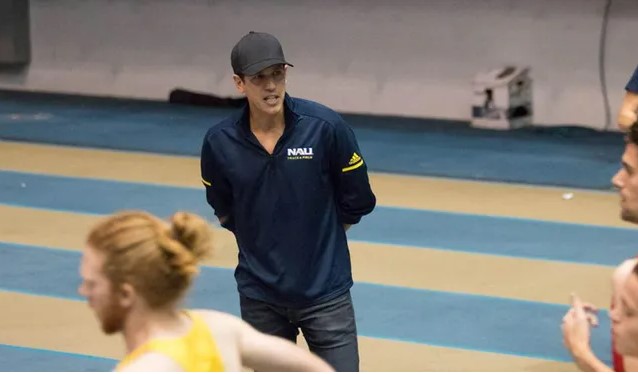
FRN: During college track and cross country season, are you still writing workouts for your pros, Abdihamid and Luis, say?
Smith: Oh, yeah, completely.
FRN: So, I picture you at home at night, playing with Nova but then also writing workouts late?
Smith. No. Well, yeah. Listen, when you are coaching people trying to medal in the Olympics, you aren’t messing around. That’s a huge responsibility. That’s a big reason why, at this time, I don’t take anyone else on (pro runners). That training has to be exact and precise and build upon previous training. You also have to be around the athletes so you can read them and know what to assign.
FRN: Is it hard to do that with the pros when you’re, say, spending a week in Bozeman (for the Big Sky Track Championships), then Arkansas (NCAA Regionals), then Eugene (NCAA finals)?
Smith: That’s the hardest part for the pro athletes, the stretches where we’re on the road for NAU. The good thing is, a lot of times it works that the college season is winding down when the pro season is ramping up. I was just two weeks at the Olympic Trials without any type of conflict.
But this is also what I, like, try to scare them (pros) away with. I try to tell them, ‘Listen, I’m not going to be at everything.’
FRN: So you need a pro who can be somewhat independent, though a lot of your pros ran for you in college and know the system?
Smith: That’s the big part. Like, Luis and Abdihamid, they’ve been in the system since they were 18 years old and they know me well. It’s different when a Nikki Hiltz or Woody Kincaid come along. They have to learn the coach.
FRN: How did you become Nikki Hiltz’s coach? They were in San Diego with Terrence Mahon, right?
Smith: Nikki was still in San Diego, and had been working with Mac Fleet after Terrence. This was during Covid. They (Hiltz) came out here for a short training camp, and they seemed to like it. Often times, I look at pairing of athletes, ones that’ll make others better. I thought, I currently train Rachel, Elly Henes. They are really strong and their gifts are more on the aerobic side at 5Ks and 10Ks. If they train with Nikki, they’re going get Nikki a lot stronger and Nikki’s going to get them a lot faster.
The way we saw the women’s 1,500 and mile being run, like you just saw in the trials, they’re going out in 2:05 (800 meters) or 2:08. Nikki always had the raw speed but to get through the middle of the race, to use that speed at the end of the race, I thought altitude would be a good match and the way we train with threshold would help them. I almost train Nikki like for the 5K and the 800 and it met in the middle at that 1,500.
“I pride myself on getting people fast and bringing those things together so they are strong enough to use their leg speed when they need it. We at NAU get a lot of attention for 10K and cross country, but that sometimes is the least interesting thing to me.”
Mike Smith
FRN: Let’s talk about coaching 1,500. People in track talk about the top coaches and their strengths – don’t get me started on letsrun.com’s message board – and some say, ‘Oh, Smith ‘s great with 5 and 10 people but the mile, no.’ But look at Nikki and Maggi Congdon and Colin Sahlman (NAU runners in the Olympic Trials 1,500.) So, how much different is it to train true middle distance, 1,500 people from 5K and 10K?
Smith: One of my mentors, Dan Pfaff, he believed that there are training theories that translated not just across events but event categories. There were postures in the body you could find in sprints and the jumps and distance. There are way more similarities than we realize. There are ways of problem solving coaches can apply to any event. To me, the aerobic side, the engine, that almost comes the easiest up here. I pride myself on getting people fast and bringing those things together so they are strong enough to use their leg speed when they need it. We at NAU get a lot of attention for 10K and cross country, but that sometimes is the least interesting thing to me.
FRN: Really? How?
Smith: We hear it in recruiting. We’ll have a kid tell us, ‘Oh, sorry, I chose fill-in-the-blank school because I really want to be a miler.’ The kid’s like, ‘Uh, I’m just going to run the 10K (at NAU).’ No, that’s not what we do. That’s other coaches telling them that.
FRN: Isn’t that perception changing? You’ve got Clay Shively, a true miler (high school in Kansas), coming in this year. You’ve got Colin and Maggi.
Smith: People who do their homework on NAU will see that we’ve won 10K national championships with guys who also have PRs under 3:40 in the 1,500. That to me is us doing our job making sure you come out on the other side as a well-balanced athlete and not boxed into one corner. A lot of people can be strong enough to get to the end of the race, but you better have the tools to use to deal with the racing.
FRN: Back to Nikki and coaching the 1,500. Nikki always seems to have good race instincts. They always seem to make the right move. How much of that is you and how much is it Nikki?
Smith: I coach Nikki differently than I coach anyone else. Nikki’s got great instincts. Nikki can be a great coach. I love asking Nikki about their experience in the race because their feedback is spot on. When an athlete’s instincts are good, some of it is getting out of the way and not overcoaching.
FRN: But doesn’t it take a few years. You’re probably still teaching Colin tactics, right?
Smith: The tactical side is everything in championship racing. Before the 1,500 Olympic Trials finals we (he and Hiltz) talked about different scenarios and things to pay attention to, a little reinforcement on the race plan, and then I get out of the way. There’s a lot of over-inserting yourself that coaches do.
But athletes like Nico Young and Colin, with tactics, well, they were so good in high school that there’s no tactics. I asked, ‘Nico, when was the last time you had anyone on your left or right (in high school)?’ He was like, ‘Uh, maybe sophomore year.’ Well, he didn’t know anything about that (as a freshman) and that’s all college running is going to be. They had to start at ground zero with tactics. I mean, Colin, the difference between his sophomore year to his freshman year was astronomical. His freshman year, he was like a rally talented guy, but like a baby deer out there (Smith waves his arms wildly). His NCAA final this year, it was an accumulation of all he’s learned. Now, he didn’t win, but there was such growth in his movement inside the races. I’d say the same thing with Maggi and tactics.
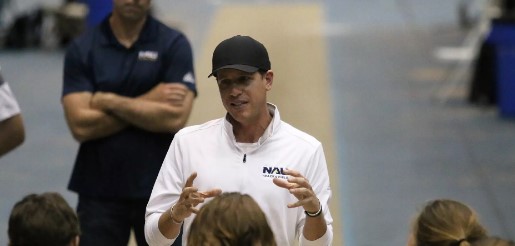
FRN: Let’s switch to your 5K and 10K Olympic athletes. Woody dealt with injuries. Luis had a sacrum stress fracture. So how has their build-ups gone, given the injuries?
Smith: Luis is a guy who never got hurt in college. That sounds like it’s really good, but as a pro, it’s really bad because you take that for granted. This fall, he had a sacrum stress reaction (after his season). It came at a good time, It cost him an indoor season, but where I’ll give him credit is, he worked his butt off in the pool. He has no background in swimming, clearly. The lifeguards would sit a little closer when he swam. There were a bunch of triathlon guys going (to the pool) at lunchtime and he got hooked in with them. Next thing I know, he’s walking in with a swim cap. I tell you what, I’ve never seen anything like it. He came out of it, and it was like he was never even hurt.
FRN: At Sound Running’s The Ten in March, he looked pretty good (27:26.02) considering he hadn’t run.
Smith: If you knew what he’d done, man. I mean, Abdihamid and Woody had been building up for months for The Ten. Luis was in the pool. And he jumped in there and I was really proud of him.
FRN: And Woody?
Smith: It was a mix. Sometimes, it would manifest in his hip, sometimes more like his hamstring or quad. Someone referred to it as quad splints. What was really scary is, he went to the Olympic training center and got several MRIs on the hip and sacrum. A lot of the things he was describing sounded bony. And bony would be a season-ender for April and May. It cleared up after time, but Woody lost some significant weeks. He’s a guy who pushes himself so hard. At Bowerman, back in the day, every workout was like, game-on. And so, he naturally at his age (31) thinks, push, push, push.
FRN: Did you have to change his mindset when he came from Bowerman?
Smith: Yeah. He’d get here and say, ‘You guys aren’t working hard enough.’
FRN: Isn’t there a point of diminishing returns?
Smith: Yes. I mean, Woody, our threshold is at altitude. It’s high volume but it’s not like you’re arrrgh (physically spent). You have to realize that.
FRN: What made you take on Woody?
Smith: Luis and Abdihamid really needed someone older who had experience and raced all around the world and been at the Olympic Games. Those guys (Grijalva and Nur) are proud and act like they knew everything, but as a coach, if I just left it to the two of them, suddenly, Luis is the expert.
FRN: And you can’t be at every workout, right?
Smith: Right. I felt Woody would help. But the first time Woody called me, I said, ‘I can’t take anybody else.’ I promised Rachel I wouldn’t take anyone else. Like, Rachel would kill me. He called me back a couple weeks later, said, ‘I’m coming to Flagstaff anyway, can I just do whatever your guys are doing? You don’t need to coach me.’ I thought it would be good. Sometimes, having guests in town mixes it up a little. It made our guys better. It made Woody better. Woody was not high maintenance. After a while, (Kincaid) was like, can we just keep doing what we’re doing?’ Yeah. Next thing I know, how the hell did he talk me into this?
FRN: And Rachel’s fine with it?
Smith: (laughing) yeah, yeah.
“If you want to see something crazy, watch what (Nico) does next year. Because you’re going to take that athlete we had this year but you’re now going to be able to control the schedule and the peaking. This year: not ideal scheduling and peaking because we’re bound to certain things. Next year: complete control. I think it’s going to be a special thing to witness.”
Mike Smith on Nico Young
FRN: Turning to Nico. It’s been a long season for him. Was he tired at the Trials?
Smith: He was, yes.
FRN: What have you done, post-Trials, to rejuvenate?
Smith: People think college coaches, we’re just reckless and run, run, run and race them all the time. We’re aware of the risks this year. The shape he was in January through May was like absurd, incredible. When he went to shift the gear off the gear off the gear he had was unbelievable. What we saw late season, NCAAs regionals, then Eugene and then the Trials, he was a little off.
It’s an understanding now that rest is what allows you to access the fitness. Rest is what unlocks the door to fitness. The opposite of that would be to say, ‘The Olympics are coming, we’ve got to push, push, push.’ We had to get his volume back up. Now that he’s signed the pro contract, that part is done. We’re giving him low stress. Don’t do anything that’s going to neurologically stress you out.
FRN: Where do you see Nico’s ceiling and future? Still the 10K? Marathon maybe?
Smith: Down the line, he’d do great on the roads. But, actually, I want to go back to the mile and 1,500 with him next year and come at these longer events from that side. I think he could’ve broken 3:50 in the mile this year. That (3:50) athlete at the end of a 5K is going to be hard to deal with. We’re always going to keep his speed as the centerpiece of what we do. Even if we go up to the longer stuff, we’ll never get away from that speed.
If you want to see something crazy, watch what (Nico) does next year. Because you’re going to take that athlete we had this year but you’re now going to be able to control the schedule and the peaking. This year: not ideal scheduling and peaking because we’re bound to certain things. Next year: complete control. I think it’s going to be a special thing to witness.
FRN: Let’s go back to college and your career. We’ve already talked about how much you are working, but it seems college coaching has changed with the transfer portal and NILs. It seems different now than 2017, right? I was reading Matt Baxter’s book about NAU: (Coach Ron) Mann to (Eric) Heins to Smith. It got me thinking, you could be a pro coach full-time now, right? What are your thoughts on that?
Smith: That, for sure, has been on my mind at times. Should we choose one or the other. Especially for family reasons. Those are big discussions we (he and Rachel) have had over time. But the thing pro coaching doesn’t have is, well, college coaching is teaching them. You’re getting them at such a pivotal time in their lives. Only one part is getting them faster. They grow and mature as people. You feel so lucky to be part of anyone’s journey like that. Pro coaching? I’m not saying you can’t have that, but it’s more transactional. In college, it is like teaching. You’re using sport to change who they are and who they want to become.
To do that at NAU is a dream come true. This is my dream job.
FRN: Thanks for the transition, Mike. Oregon came after you and you signed a new contract (at NAU). Did you consider jumping to Oregon? You know, the storied program and all.
Smith: I’ve had different opportunities over the years to go to places with different advantages. When these other places come approach me, they look up and see what they pay him at NAU. Well, OK, we can beat that. They don’t understand how personal it is, Flagstaff to me. … The day this job opened up, I looked to the sky – I didn’t even know who I was talking to – but I said if you let me be the NAU coach, I won’t ask for anything else. These other places, I don’t know.
FRN: There is a job currently open in Boulder (University of Colorado). Have they contacted you?
Smith: No comment.
FRN: OK, moving on.
Smith: Wait. Let me say, that (Colorado) is one of the best distance jobs in the country. But this is Flagstaff. I get to be the NAU coach in Flagstaff. This is it. But, yeah, the NCAA is changing a lot.
“When these other places come approach me, they look up and see what they pay him at NAU. Well, OK, we can beat that. They don’t understand how personal it is, Flagstaff to me. … The day this job opened up, I looked to the sky – I didn’t even know who I was talking to – but I said if you let me be the NAU coach, I won’t ask for anything else. These other places, I don’t know.”
Mike Smith
FRN: Let me ask about the portal. You gained quality women from the portal, but the only men I can think of are George Kusche and Aaron Las Heras. It’s interesting that you don’t go to the portal a lot. Does a runner have to fit the NAU mold, personality-wise, blending in teamwise?
Smith: The portal. I can’t even imagine football and basketball, where their whole roster goes.
FRN: Would you rather not have the portal?
Smith: Now, it’s all about empowering the athletes, right? That came about from people thinking (universities) were blocking people from leaving. You (as a coach) are forced to play a game that you don’t want to play, but you have to, because our competitors are playing it. We always pride ourselves on building a team, not just assembling a team. Like, ‘All right. Who are the best people? Who cares if they get along? Who cares if they speak English. Who cares? Just put them together, put them on the line.’ But we pride ourselves on building a team that fits our culture.
I’ll admit. You are forced to bend some of your own rules sometimes. What scares me would be taking people that we haven’t done as much homework on as we like. These high school kids, we’re recruiting them for two years. By the end of that, we know them. Now we’re in a situation (with the portal) where you have to make some quick decisions on game-changing people.
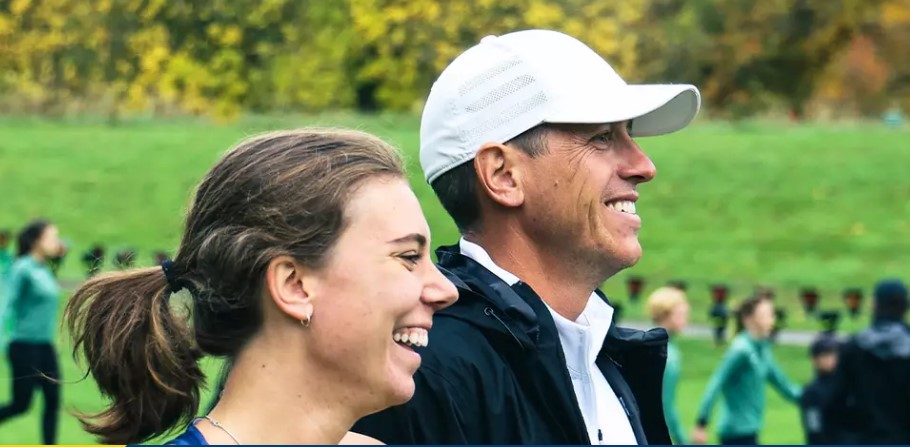
FRN: It seems your women’s team coalesced well with the four new additions last year.
Smith: We ask the right questions. I’m listening for real particular ways of answering questions. That tells me how they’re going to fit with the team. Sometimes, I try to scare people. I say, ‘This is not about you. This is about the team here.’ But when you have a good culture in place, the Annikas (Reiss) and Maggis, then the Gracelyns (Larkin) can come in to something that’s already formed.
We just can’t look at how fast they are. Believe me, the list of people we’ve said no to, the accolades, it’s definitely cost us places at the NCAA meet. … I get the temptation. Some of the new additions to schools in the NCAA, they are literally pro runners. I get it, but we’ve done pretty well so far by keeping to our guns on how we do things. I have no judgment of other places.
FRN: Before I go, I wanted to ask. One thing that’s really struck me about pro running and college compared to other sports is that no one ever talks about injuries at the time, why somebody didn’t run in a meet or race. People just disappear.
Smith: Yeah, for like a major league baseball player, you have to have a press conference. I get it.
FRN: So, like, for instance, what happened to Drew Bosley this spring? It’s like he fell off the face of the earth.
Smith: I get what you’re saying. Some of it is, we’re all playing poker and it’s psychological. I know some athletes who’ll change their whole workout day so no one will see it. There are days on the NAU track where, if you have a bad workout, the whole world is going to know.
OK, Drew Bosley. This is a weird one. I mean, he’s as good as they come, one of the best of the best. He’s not hurt. He’s just not moving correctly. And if we trained him, he’d get hurt.
FRN: His mechanics?
Smith: Yup. His form is off. If we’d run him through this, he’d get serious bone injuries. It’s a matter of undoing this mess. It really came about over the winter break – 7 months ago. … He did limited racing indoors, but I said, outdoors, you are not pushing through this. He’s getting it going again this summer. He doesn’t have cross country eligibility, but he’s got indoors and outdoors. It’ll be December when he gets going, that first BU (Boston) meet.
FRN: Elise Stearns, who has been injured, is coming back to cross country. Your women’s team is loaded, adding Alyson Churchill (Florida State) and Alex Carlson (Rutgers). You were one point away from winning the title last year. How gratifying would it be on a personal level for you to win a women’s title?
Smith: Forever, the men have dominated. There have absolutely been highlight moments for our women’s program, but the men have dominated the conversation. When I first got to NAU, a week or two into the job, they did a whole meet-the-new-coach thing at the Skydome. And 20 people came out. Someone asked, what’s going to happen with the women’s team. At the time, we weren’t even at the national meet. I’ve said this all along. There’s no reason the men can do it but the women c
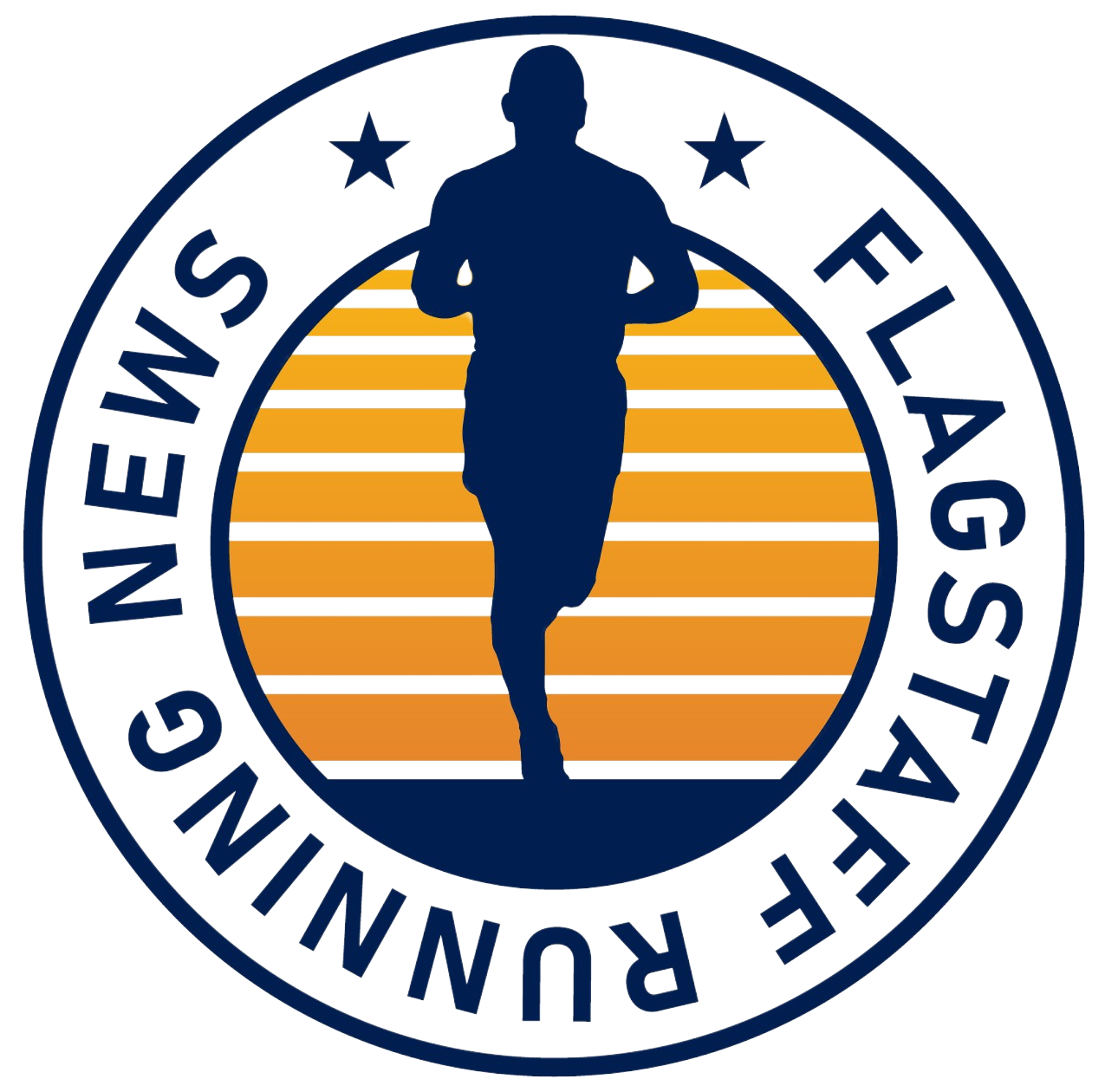
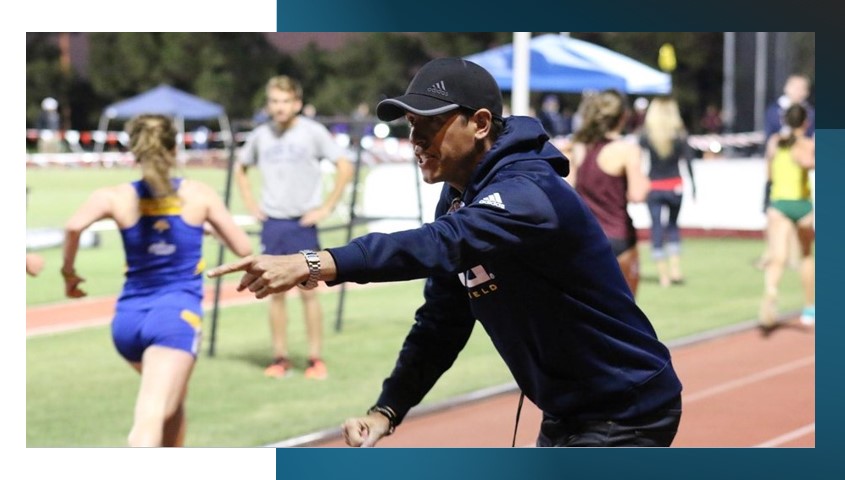
Leave a Reply